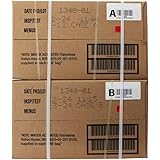- 1. LED Emergency Lights
- 2. Photoluminescent Pathway Markers
- 3. Powered Exit Signs
- 4. Self-Contained Backup Lighting
- 5. Inverter-Driven Emergency Lights
- 6. Drone Tower Emergency Lighting
- 7. Smart LED Emergency Lighting Systems
- 8. Battery Backup Spotlights
- 9. Hardwired Emergency Lighting
- 10. Wireless Connected Emergency Lighting
1. LED Emergency Lights
Efficiency and Longevity
LED emergency lights have become the standard in 2025, thanks to their exceptional energy efficiency and long lifespan. Unlike traditional incandescent or fluorescent options, LEDs consume up to 80% less energy, reducing operational costs significantly for businesses and institutions. They typically last over 50,000 hours, meaning less frequent replacements and maintenance, which is vital in emergency scenarios.
In real-world applications, LED emergency lighting systems can stay operational during extended power outages, ensuring safety when it’s most critical. Their durability makes them suitable for diverse environments, from commercial buildings to industrial facilities, where harsh conditions could otherwise compromise traditional lighting systems.
To maximize benefits, opt for high-quality LED emergency lights with certifications such as UL924 or IEC standards. They also offer a wide range of color temperatures and brightness options, tailored for different safety needs.
Innovative Features for 2025
Modern LED emergency lights incorporate smart sensors that adjust brightness based on ambient light levels or movement, conserving energy and increasing visibility. Integration with building automation systems allows for real-time status updates and remote testing, which is especially useful in large facilities.
Some models are now equipped with wireless controls, enabling quick deployment and flexibility during emergencies. Additionally, advancements in battery technology, like lithium-ion batteries, ensure longer backup times and faster charging cyclesâcrucial for compliance with 2025 safety standards.
== > What if ... Get a FREE Subscription to PREPARE
In summary, LED emergency lights are unrivaled for their efficiency and adaptability, making them a top choice in emergency lighting options for 2025.
2. Photoluminescent Pathway Markers
Passive Safety Solutions
Photoluminescent pathway markers are an innovative, low-cost emergency lighting option that absorb and store ambient light during the day or lit periods. In a power outage, these markers glow in the dark, guiding occupants safely towards exits without requiring electrical power.
They are particularly useful in situations where continuous electrical infrastructure may be impractical or cost-prohibitive, such as in historic buildings or outdoor complexes. Their passive nature means little to no maintenance, making them a sustainable choice for long-term safety planning.
By 2025, new formulations have improved the brightness duration and visibility of photoluminescent markers, with some capable of glowing for up to 12 hours after exposure to light. They also meet strict fire safety and environmental standards, making them versatile for various settings.
Practical Deployment Tips
For optimal effectiveness, install photoluminescent markers at regular intervals along escape routes, stairwells, and exits. Regularly ensure they receive sufficient light exposure during operational hours to maintain their glow in emergencies.
Combine these markers with other emergency lighting options for comprehensive safety coverage. They’re particularly valuable in corridors, tunnels, and outdoor pathways where electrical options may be limited.
In conclusion, photoluminescent pathway markers serve as an affordable and eco-friendly component of emergency lighting options in 2025, especially when passive safety measures are preferred.
3. Powered Exit Signs
Visibility and Compliance
Powered exit signs remain a cornerstone of emergency lighting options, providing clear and illuminated pathway indicators during outages. In 2025, most exit signs are equipped with LED technology for bright, consistent illumination with minimal energy use.
These signs are a critical component of safety compliance standards globally, including OSHA and NFPA requirements. They often include battery backup systems that ensure visibility for at least 90 minutes during power failures.
Advanced models include features like directional arrows, fluorescent glow-in-the-dark faces, and remote mounting options to integrate seamlessly into modern building designs and fire safety protocols.
Innovations in Exit Sign Technology
Smart exit signs now feature IoT connectivity, allowing facility managers to monitor their operational status remotely. This helps ensure continuous compliance and prompt maintenance before signs fail.
Some units are equipped with programmable messaging systems, which can display safety instructions or emergency alerts during crises. These adaptable features enhance overall safety and situational awareness in emergencies.
To choose the best powered exit signs, consider their brightness, battery backup duration, and compliance certifications to meet local regulations in 2025.
4. Self-Contained Backup Lighting
Independent Emergency Power
Self-contained backup lighting units are standalone systems that combine rechargeable batteries with LED or fluorescent lights. They are ideal for areas where wiring might be difficult or too expensive to install, such as temporary setups or renovation sites.
In 2025, these systems boast quick installation, with many designed for plug-and-play operation. Their portability allows for easy repositioning during drills or emergencies, providing flexible safety solutions.
Battery technology has significantly improved, with lithium-ion batteries providing longer backup durationsâoften up to 3 hours or moreâand faster recharge times. This ensures readiness even during extended outages.
Best Practices for Usage
Proper placement is key; install self-contained units in pathways, stairwells, or dark corners where additional visibility is needed. Regular testing and maintenance are essential to guarantee operation during real emergencies.
Consider models with built-in test functions that automatically check battery health and notify users of any issues. This proactive approach reduces downtime and enhances safety compliance.
Overall, self-contained backup lighting offers an effective, easy-to-deploy emergency lighting option aligned with 2025 safety standards and cost considerations.
5. Inverter-Driven Emergency Lights
Hybrid Power Solutions
Inverter-driven emergency lights combine traditional electrical supply with battery backup systems that are powered by inverters. This hybrid approach ensures continuous lighting during mains power failures while maintaining energy efficiency.
In 2025, these systems are increasingly embracing solar power integration, reducing reliance on grid electricity and enhancing sustainability. They are particularly suited for off-grid facilities, remote locations, or eco-conscious organizations.
The inverter technology provides clean, flicker-free illumination, minimizing eye strain and enhancing occupant comfort during emergencies. Additionally, smart inverters can communicate with building management systems for real-time diagnostics.
Implementation Tips
Choose inverter-driven emergency lighting solutions with sufficient capacity for your building size and safety requirements. Regular testing is crucialâ2025 models often include automated self-test features for convenience.
Integrate these systems with existing green energy initiatives to optimize both safety and environmental impact. Proper maintenance of batteries and inverters extends the lifespan and ensures compliance with emergent standards.
In summary, inverter-driven emergency lights are a future-proof, sustainable choice that aligns with the evolving landscape of emergency lighting options in 2025.
6. Drone Tower Emergency Lighting
Innovative Aerial Lighting Solutions
Drone-based emergency lighting is an emerging technology that offers rapid deployment in large or complex areas, such as disaster zones or sprawling construction sites. These autonomous drones can carry high-intensity lights to illuminate critical zones effectively.
Get Preparedness and Self-Reliance Tips. Subscribe Now!Â
In 2025, advancements in drone technology have made these devices more autonomous, with longer flight times and obstacle avoidance features. They serve as temporary, mobile lighting sources, especially when ground-based options are unavailable or unsafe.
This approach also enhances safety by reducing the need for personnel to access hazardous areas during emergencies. Their quick deployment can be critical in search-and-rescue operations and large-scale evacuations.
Operational Considerations
- Ensure adherence to aviation regulations and drone safety standards in your region.
- Regular maintenance and software updates are essential for capability and safety.
- Combine drone lighting with ground-based emergency options for comprehensive safety coverage.
Drone tower emergency lighting exemplifies how innovation continues to shape emergency lighting options in 2025, providing flexible, rapid-response solutions.
7. Smart LED Emergency Lighting Systems
Integration and Automation
Smart LED emergency lighting systems leverage IoT technology, enabling real-time monitoring, remote control, and automatic testing. These features help facilities maintain high safety standards effortlessly in 2025.
Automated diagnostics can detect failures instantly, minimizing downtime and ensuring compliance with fire safety codes. Facility managers appreciate the ability to remotely activate or dim lights, optimize energy use, and receive alerts if maintenance is required.
Some systems incorporate adaptive lighting that dynamically adjusts brightness based on ambient conditions or occupancy levels, providing both energy efficiency and safety during emergencies.
Advantages for Modern Facilities
With integrated sensors and network connectivity, smart LED emergency lights can be part of a broader building automation system, enhancing overall safety management. They support data collection for safety audits and compliance documentation.
These systems are increasingly affordable, offering rapid ROI through energy savings and reduced maintenance costs. They are a prime example of how innovation is transforming emergency lighting options for 2025 environments.
In sum, smart LED emergency lighting solutions are indispensable for modern, tech-savvy facilities seeking reliable, efficient, and controllable safety systems.
8. Battery Backup Spotlights
Localized Emergency Lighting
Battery backup spotlights are portable, high-intensity lights designed to provide focused illumination during emergencies. They’re excellent for evacuations, search-and-rescue, or temporary safety zones.
In 2025, these units feature LED technology for brightness and long-lasting batteries that can operate for several hours. Rechargeable lithium-ion batteries are standard, offering quick recharging after use and maintaining readiness.
Their handheld or stand-mounted design offers flexibility, making them popular among emergency responders and facility personnel alike.
Using Battery Backup Spotlights Effectively
Strategically place these spotlights along key evacuation routes and in areas where fixed lighting is unavailable. Regular testing is critical to ensure functionality when needed.
Incorporate them into your emergency preparedness plans, and ensure staff are trained in their operation. Their portability makes them an essential component of a comprehensive emergency lighting options toolkit in 2025.
Overall, battery backup spotlights provide reliable, immediate lighting when permanent solutions are inadequate or unavailable.
9. Hardwired Emergency Lighting
Design Integration and Reliability
Hardwired emergency lights are permanently installed fixtures wired into the buildingâs electrical system, providing consistent and reliable illumination during outages. In 2025, these lights are often integrated with building management systems for enhanced control and monitoring.
They typically use LED lamps, which offer energy efficiency and longevity. Backup power during outages is maintained through dedicated batteries or connection to uninterruptible power supplies (UPS).
These systems are ideal for high-traffic, high-risk environments like hospitals, airports, and manufacturing plants where safety cannot be compromised.
Maintenance and Upgrades
Regular testing, maintenance, and adherence to standards like NFPA 101 are necessary to ensure system readiness. Advanced diagnostic features can notify facility managers of faults remotely, reducing downtime.
Upgrading older systems with energy-efficient LEDs and smarter controls aligns with 2025 sustainability goals and regulatory updates.
Hardwired emergency lighting remains a dependable cornerstone of emergency preparedness in modern facilities.
10. Wireless Connected Emergency Lighting
Flexibility and Control
Wireless connected emergency lighting options are rapidly gaining popularity in 2025. These systems use Wi-Fi or Bluetooth connectivity to allow centralized control, monitoring, and maintenance of multiple fixtures remotely.
This approach simplifies installation, especially in complex or historically preserved buildings where wiring modifications can be challenging. Wireless systems are also easier to upgrade and expand, offering scalable safety solutions.
The ability to perform diagnostics remotely enhances system reliability and simplifies compliance reporting, making them a preferred choice for dynamic environments like educational campuses and commercial complexes.
Implementation Tips
- Invest in secure, encrypted communication protocols to prevent hacking or interference.
- Regularly update firmware to benefit from patches and new features in 2025 systems.
- Combine with smart building management to integrate emergency lighting control into existing automation platforms.
Wireless connected emergency lighting options deliver unparalleled flexibility, efficiency, and control, reinforcing their role among top emergency lighting options for 2025.
Conclusion
Choosing the right emergency lighting options is crucial for safety, compliance, and operational efficiency in 2025. From energy-efficient LEDs to innovative drone solutions and smart connected systems, thereâs a diverse array of options to suit every need. The importance of reliable emergency lighting options cannot be overstated; they are the backbone of effective emergency preparedness and occupant safety. As technology continues to advance, staying informed about the latest solutions ensures your facility remains compliant and ready for any unforeseen event. For anyone serious about safety in 2025, selecting the most suitable emergency lighting options is a decision that provides peace of mind and protection for all.
Frequently Asked Questions
What are the best emergency lighting options for large commercial buildings in 2025?
In large commercial settings, smart LED emergency lighting systems, hardwired emergency lights, and drone tower lighting are among the top options, offering scalability, control, and rapid deployment capabilities.
How do I ensure my emergency lighting options stay compliant in 2025?
Regular testing, maintenance, and installation of certified systems such as UL924-compliant LED lights, exit signs, and battery backups are essential. Incorporating modern smart systems also helps monitor compliance status remotely.
What new innovations are shaping emergency lighting options in 2025?
Advancements include wireless control systems, IoT-enabled smart lighting, drone-based aerial illumination, and renewable energy integrations like solar-powered emergency lights. These innovations improve responsiveness, sustainability, and ease of management.
Can photoluminescent markers replace electrical emergency lighting options?
Photoluminescent markers are a passive safety solution ideal for guiding occupants in conjunction with electrical emergency lighting, but they cannot fully replace active lighting options. Combining both provides a comprehensive safety plan.
Why are LED emergency lights preferred in 2025?
LED emergency lights are favored due to their efficiency, long lifespan, low maintenance, and improved brightness. Their adaptability with smart technology also makes them the leading choice for modern safety systems.
Get Preparedness and Self-Reliance Tips. Subscribe Now!Â
Related Content
SavorSatch Dried Red & Green Bell Pepper Flakes – 8oz Resealable Pouch | Dehydrated, Certified Kosher, Non-GMO | Perfect for Cooking, Soups, Stews, Camping, Emergency Food Supply
$11.99 (as of December 25, 2025 18:19 GMT -05:00 - More infoProduct prices and availability are accurate as of the date/time indicated and are subject to change. Any price and availability information displayed on [relevant Amazon Site(s), as applicable] at the time of purchase will apply to the purchase of this product.)Hitituto Rain Ponchos Family Pack Kids– 6/12/24 Pack Disposable Poncho with Hood, Clear & Assorted Colors, Home Survival Kits
$8.49 (as of December 25, 2025 18:19 GMT -05:00 - More infoProduct prices and availability are accurate as of the date/time indicated and are subject to change. Any price and availability information displayed on [relevant Amazon Site(s), as applicable] at the time of purchase will apply to the purchase of this product.)Meals Ready to Eat A and B bundle cases 2025, 2026 inspection. Genuine Military US surplus emergency food bulk supply full box with heater
$79.95 (as of December 25, 2025 18:19 GMT -05:00 - More infoProduct prices and availability are accurate as of the date/time indicated and are subject to change. Any price and availability information displayed on [relevant Amazon Site(s), as applicable] at the time of purchase will apply to the purchase of this product.)Wornick Sopacko, Ameriqual MRE Meals Ready to Eat Inspection 2025, 2026 or Better, Emergency Food Supply, Survival Camping Outdoor 12 Pack(A & B Case Bundle, 2, Count)
Now retrieving the price.
(as of December 25, 2025 18:19 GMT -05:00 - More infoProduct prices and availability are accurate as of the date/time indicated and are subject to change. Any price and availability information displayed on [relevant Amazon Site(s), as applicable] at the time of purchase will apply to the purchase of this product.)





